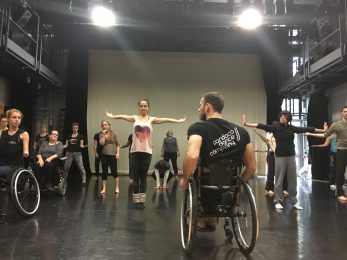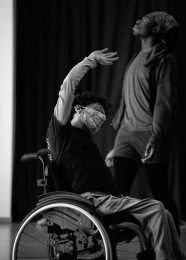Inclusive dance teaching is really just good dance teaching

The Teacher Training Intensive is a core part of Candoco’s learning programme, where we are able to share our knowledge and be inspired by new ways of working.
Two participants from this session share their experiences:
Rebecca Tattersal
I am a yoga teacher as well as a dancer, and I wanted to take the TTI to further my practice as a teacher in both of these areas. People so often think that to be a dancer or a yogi you have to be a certain type of person, a certain type of body, and I try to show people through my teaching that this is not the case- that ANY body can do these practices. So I wanted to take the TTI to help me realise this further, to give me more inclusive techniques, and to challenge my own preconceptions.
I have loved Candoco’s work for such a long time, and always have wanted to be involved with them. I joined Cando2, Candoco’s youth company, a year ago, which I love being part of. When I heard about the TTI, I knew straight away that I wanted to attend, both to improve my teaching and dance practice, and also as a way to see more of how Candoco works.
The TTI has helped my teaching practice in many ways. Firstly, it has given me an incredible community of dancers and teachers to bounce ideas off and learn from. It also gave me many practical tools, structures and exercises to include in my teaching. One of the most invaluable sections of the TTI was our discussion of models of disability, and language to use when talking about disability: this really challenged all of us to think about our use of language, and this about what it means to be an inclusive dancer.
I would want more and more people to want to get involved! I want all dance classes to be inclusive! As Adam said on day one: “inclusive dance teaching is really just good dance teaching”. This was really a take home message for me- there is nothing special or different about inclusive dance, it is just people dancing, and that’s a wonderful thing.
Scout Davies
I dance with Cando2 and am aware of their practice/inclusive approach, and wanted to learn more and be able to utilise this within my work. I am greatly interested in using dance and movement to work with disabled and SEN groups, and I felt that it would complement my work with the Dance and Museums Network, provoking further thinking into how movement can be incorporated into museum/gallery spaces.
I wanted to look at challenging perspectives of ability, and to find out more about language usage and access needs, making sure these are considered from the initial stages of a project in order to ensure workshops/learning programmes are accessible both in terms of the activities themselves and also in their marketing and communications.
I now feel more aware of inclusive practice and it has supplemented my understanding. I came up with an idea that I could implement as a workshop in a museum/gallery setting and had the chance to trial this with the group. Through the teaching element and creative tasks I feel I have gained some great practical tools and ideas for workshops/sessions which would be relatively easy to adapt for different needs. The partner and small group work emphasised the use of sensory information and touch when working with mixed groups. The talk with Tanja and Joel about models of disability, language use and adaptation vs translation was particularly useful and I personally found it the best part of the training as it was a very real, open and honest discussion that really got everyone in the room thinking. I felt that a lot of joined up thinking and learning occurred and it was great to get information from such a variety of different people.


